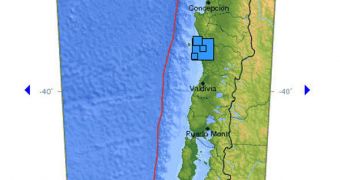Yesterday evening, on Sunday, January 2, a large earthquake shook the grounds near the city of Temuco, in Chile. The tremor had an intensity of 7.1 degrees of magnitude of the Richter scale.
The devastation struck at 3:20 EST (2020 GMT), but thus far no official reports on casualties or material damages have been made available to the media.
Initial estimates suggest that the scale of the devastation is very narrow and that the strong tremor and its aftershocks, did not cause significant damages, or loss of human lives. After the initial seismic event, a magnitude-5.0 one soon followed, but it too apparently made no victims.
Researchers in the United States who analyzed the first details about the earthquake say that they are not expecting any major tsunamis in the Pacific Ocean following the rearrangement of Earth's tectonic plates. Chile is located in the Pacific Ring of Fire.
This area, which encircles the entire ocean, is the most volcanically and seismically active in the entire world, and it stretches from Alaska to Chile, to northern Australia and Japan.
“A strong earthquake has occurred, but a tsunami IS NOT expected along the California, Oregon, Washington, British Columbia, or Alaska coast. NO tsunami warning, watch or advisory is in effect for these areas,” US experts said in a brief statement.
The team that analyzed the risk is based at the West Coast and Alaska Tsunami Warning Center. Data collected during their study show that another earthquake took place in South America Saturday.
Scientists say that a magnitude 7.0 tremor struck Argentina on January 1, but add that the event was unrelated to the Chilean tremor. Both South and Central America have suffered numerous earthquakes over the past year, which caused a massive number of victims.
For example, the 8.8-magnitude tremor that struck the Chilean coast in February of last year moved the city of Concepción by more than 3 meters. Its effects stretched to Argentina, on the Atlantic border of South America.
That particular tremor even managed to shift Earth's rotation axis by a few centimeters. Many cities near the epicenter of the disaster shifted their positions on the map, as showed by GPS measurements.
Then there was that January 12, 2010 Haiti earthquake, one of the most brutal natural disasters of the last decade. It claimed the lives of an estimated 230,000 people in one of the most impoverished nations of the world.
Additional earthquakes took place in Mexico and California in mid-April 2010, experts add. This many high-magnitude tremors in such a short time span could mean that the entire Ring of Fire system is rearranging itself, LiveScience reports.

 14 DAY TRIAL //
14 DAY TRIAL //